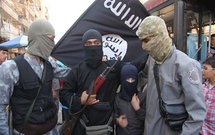 As violent jihadis activities in Syria and Iraq intensify, the number of foreign nationals enrolling to fight for the Islamic State (IS) is witnessing an exponential growth.
As violent jihadis activities in Syria and Iraq intensify, the number of foreign nationals enrolling to fight for the Islamic State (IS) is witnessing an exponential growth.
The case of Central Asian jihadis - fighters who are nationals of Tajikstan, Uzbekistan, Kazakhstan, Kyrgyzstan and Turkmenistan - joining the Islamic State (IS) is interesting, especially given the political history of the region’s neighbourhood. Despite the involvement of Central Asian-origin people in the insurgency in Afghanistan over the past few years, several Central Asian radical Islamists have chosen to travel to Syria and Iraq instead of the former. There is a need to understand why nationals of Central Asian countries are joining the IS.
Central Asian Jihadis in Syria and Iraq
Today, there are an estimated 31,500 jihadis who fight under the IS’s banner in Syria and Iraq. Approximately 15,000 of them are estimated to be foreign fighters and 2000 of them are pitted as from Western countries. While the numbers of nationals of Western countries joining the IS are easier to find, the numbers of their Central Asian counterparts are comparatively difficult to obtain and/or ascertain. Some recent estimates pit the number at anywhere between 3000-4000, with Tajiks constituting the largest chunk. According to reports, there are about “250 Kazakh citizens, 100 Kyrgyz, 190 Tajiks, 500 Uzbeks, and about 360 Turkmens fighting alongside ISIS extremists,” that have been identified, with Turkmenistan, Kyrgyzstan being the most vulnerable to IS influence, especially via Ferghana Valley. However, these numbers too are difficult to confirm.
Motivations for Joining the IS
Some motivations for joining the IS are common between Western jihadis and Central Asian jihadis. Among those are the organisational and administrative capabilities of the IS; the quality of life assured for IS fighters (that is comparatively higher than what the Afghan Taliban or al Qaeda ever provided); the chance to be on the ‘winning side’; and the potential to settle instead of having to run for cover (as opposed to the Taliban’s experience in Afghanistan). Another reason is the relative failure of al Qaeda in comparison to the Islamic State to hold territory.
More importantly, the 1300 year old prophecy in the Hadith about a ‘malahim’ (day of reckoning) speaks about the clash of Islam and the ‘infidels’ in Dabiq, Syria, is doing the rounds in the jihadis social media. The IS has in fact been using this Hadith to legitimise its actions in Iraq and Syria, and the historical religious significance of the prophecy has managed to draw more radical Islamists towards this insurgency. So strong is this prophecy’s influence on the group, that their official magazine is called Dabiq.
To this end, the war in Afghanistan is a jihad with nationalistic contours, but the war in Syria and Iraq is transnational in nature and does not aim to end at national borders. It is about something on a much larger scale - the recreation of the world as a single world order. And coming from the present-day territories of historical Khurasan - as also emphasised by the IS - these radicalised Central Asian fighters feel obligated to join.
Noticeable Trends
This sentiment could also have been augmented by the nature of news reports that are made available in these countries. The outrage over the humanitarian crisis in Syria, Israel’s offensives in Gaza, the flux in the Egyptian political environment, and the mistreatment of Muslims on various occasions across the globe have found ample space in their media. As Christian Bleuer states in the recent Afghanistan Analysts Network report, “…this author has very rarely seen in the media, or heard in local discussions, concerns over Uyghurs, Rohingyas, Chechens, Dagestanis or Afghans.” The argument about motivations depending on the call for universal jihad to protect Muslims everywhere therefore becomes complex here. There appears to be a general tendency to know and to be concerned more with what is happening in West Asia - Arab areas in particular - than other neighbouring areas with considerable Muslim populations. This means, in many ways, the primary driver is still the attraction to the status of the Arab world than just the cause of rallying for the global Ummah.
Furthermore, it is important to note that the IS’s anti-Shia policies that otherwise do not find much resonance in the Central Asian society have begun to attract the younger generation of Kazakhs, Tajiks, Uzbeks and Kyrgyz. This is a shift from the trend followed by Central Asian recruits when they joined al Qaeda in Afghanistan. Al Qaeda’s policies have not been the elimination of Shias altogether, whereas, the IS’s policies are as much about the elimination of Shias as their goal to expand the borders of the ‘Islamic Caliphate’.
This indicates a trend of gradual Salafisation of the societies in the Central Asian republics. Ironically, the rise of al Qaeda over the past two decades has laid the groundwork for legitimising the IS’s (whom they disowned in February) agenda.
By Special Arrangement with Institute of Peace and Conflict Studies (http://www.ipcs.org)